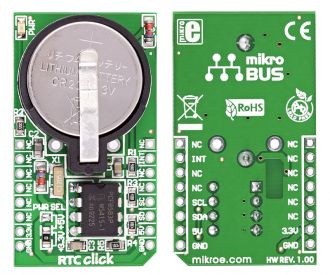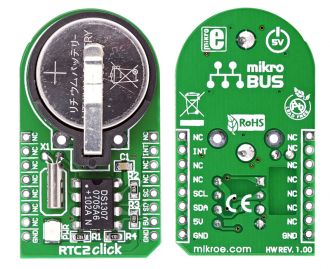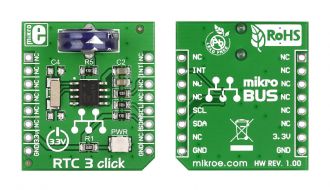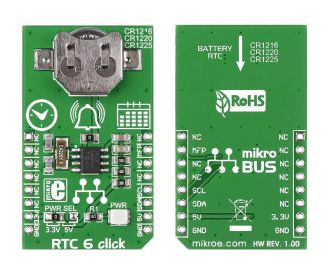
We strongly encourage users to use Package manager for sharing their code on Libstock website, because it boosts your efficiency and leaves the end user with no room for error. [more info]

Rating:
Author: MIKROE
Last Updated: 2016-05-26
Package Version: 1.0.0.1
Category: Measurement
Downloaded: 5198 times
Followed by: 14 users
License: MIT license
This library provides functions for working with all RTC clicks which use i2c communication. Functions include getting and setting GMT time, as well as local time. Calculating UNIX timestamp for both local and GMT time, and many more. NOTE: Not all functions are provided for all RTCs. As some RTCs do not support square wave output or alarms.
Do you want to subscribe in order to receive notifications regarding "RTC I2C Library" changes.
Do you want to unsubscribe in order to stop receiving notifications regarding "RTC I2C Library" changes.
Do you want to report abuse regarding "RTC I2C Library".
| DOWNLOAD LINK | RELATED COMPILER | CONTAINS |
|---|---|---|
| 1453908189_rtc_i2c_library_mikroc_arm.zip [434.05KB] | mikroC PRO for ARM |
|
| 1453908212_rtc_i2c_library_mikroc_avr.zip [359.64KB] | mikroC PRO for AVR |
|
| 1459174624_rtc_i2c_library_mikroc_dspic.zip [320.42KB] | mikroC PRO for dsPIC30/33 & PIC24 |
|
| 1453908244_rtc_i2c_library_mikroc_ft90x.zip [306.16KB] | mikroC PRO for FT90x |
|
| 1453908257_rtc_i2c_library_mikroc_pic.zip [320.55KB] | mikroC PRO for PIC |
|
| 1464257361_rtc_i2c_library_mikroc_pic32.zip [308.30KB] | mikroC PRO for PIC32 |
|
This library provides functions for working with all RTC clicks which use i2c communication. Functions include getting and setting GMT time, as well as local time. Calculating UNIX timestamp for both local and GMT time. Setting square wave output, checking for power failure, and many more. NOTE: Not all functions are provided for all RTCs. As some RTCs do not support square wave output or alarms.

Front and back view of RTC1 Click board designed in mikroBUS form factor.
View full image
Front and back view of RTC2 Click board designed in mikroBUS form factor.
View full image
Front and back view of RTC3 Click board designed in mikroBUS form factor.
View full image
Front and back view of RTC6 Click board designed in mikroBUS form factor.
View full image